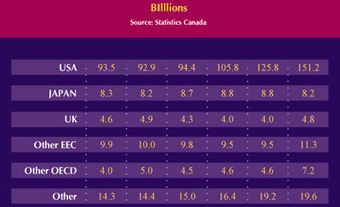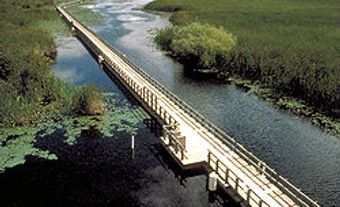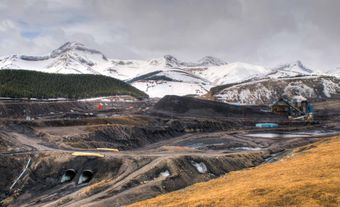There are major economic differences among Canada’s main geographic regions — Ontario, Quebec, the North, the West and Atlantic Canada — each are affected by its own history of economic development, industrial location, urbanization, land use and migration.
This is the full-length entry about regional economics in Canada. For a plain-language summary, please see Regional Economics in Canada (Plain-Language Summary).

Distribution of Economic Activity
Canada’s economy has traditionally been understood in terms of its geography (see Regionalism). Since the arrival of the first colonists, development has been heavily influenced by each region’s physical attributes. These include their access (or not) to waterways, natural resources, farmland, wild game, proximity to markets and availability of technology to exploit advantages or overcome challenges. In recent years, the economics profession has increasingly also recognized the importance of human capital. As such, a region’s economic output is highly related with its population and education levels.
Atlantic Provinces
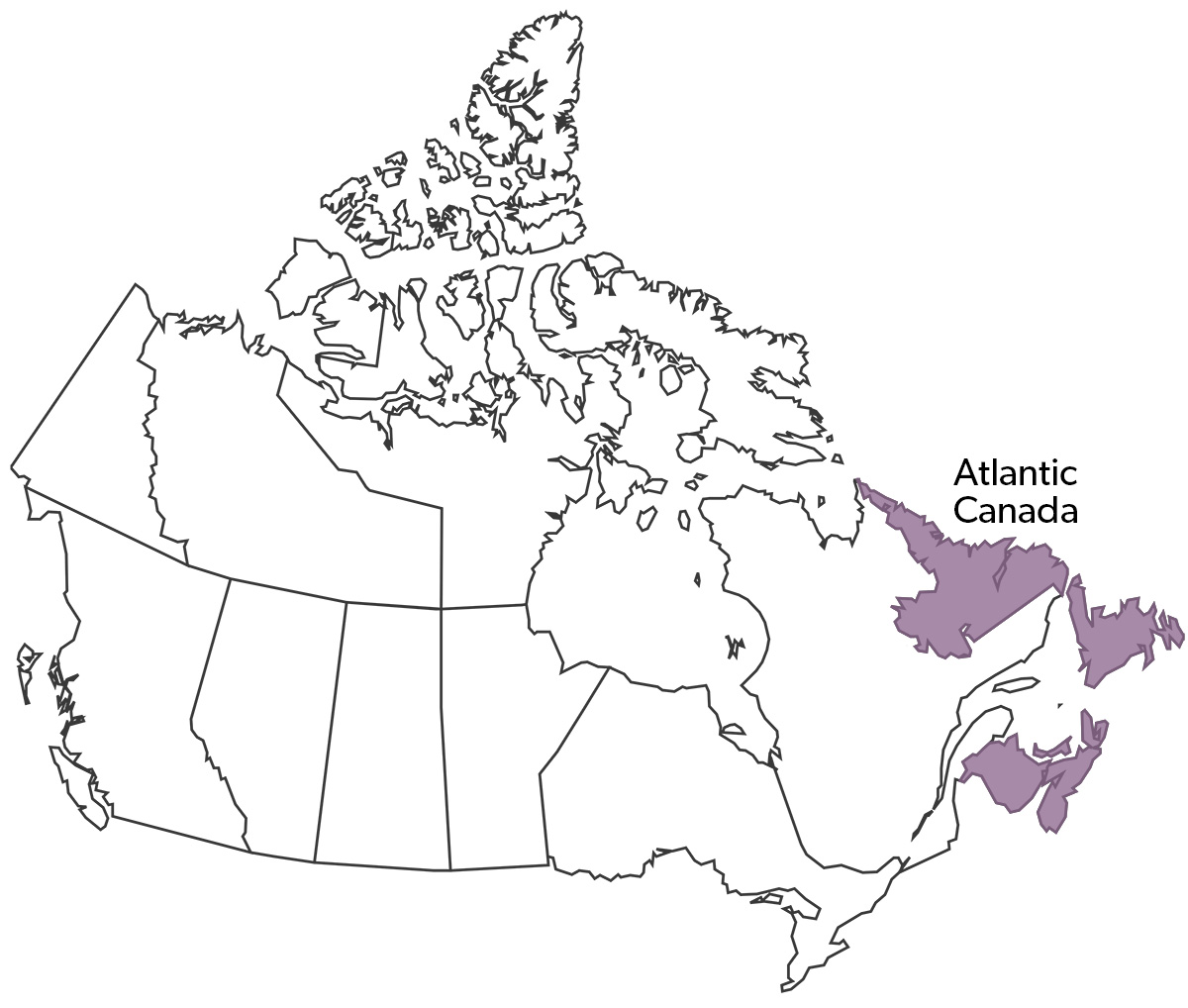
The four Atlantic provinces (Newfoundland and Labrador, New Brunswick, Prince Edward Island and Nova Scotia) have produced below-average per-person (per capita) contributions to Canada’s economy in recent decades. Together they accounted for $123 billion, or about 5.5 per cent, of Canada’s gross domestic product (GDP) in 2018. Although this was roughly the same percentage as 20 years ago, the make-up of that number has changed dramatically.
Newfoundland and Labrador, once the weakest economic province in the Atlantic region, has benefited in recent years from the development of its coveted minerals, hydroelectric capacity and offshore oil, and is now regarded as an above-average performer in terms of per-capita GDP output. Despite the devastating closure of the northern cod fishery in 1992 — the largest industrial layoff in Canadian history — fishing and fish processing remains a major economic activity in the Atlantic region (see Cod Moratorium of 1992). The port of Halifax, and to a lesser extent the ports of Saint John, New Brunswick, and St. John’s, Newfoundland, are also important economic generators.
One of the region’s biggest ongoing challenges is a lack of population growth and a rapidly aging population. (See also Economic History of Atlantic Canada.)
Quebec
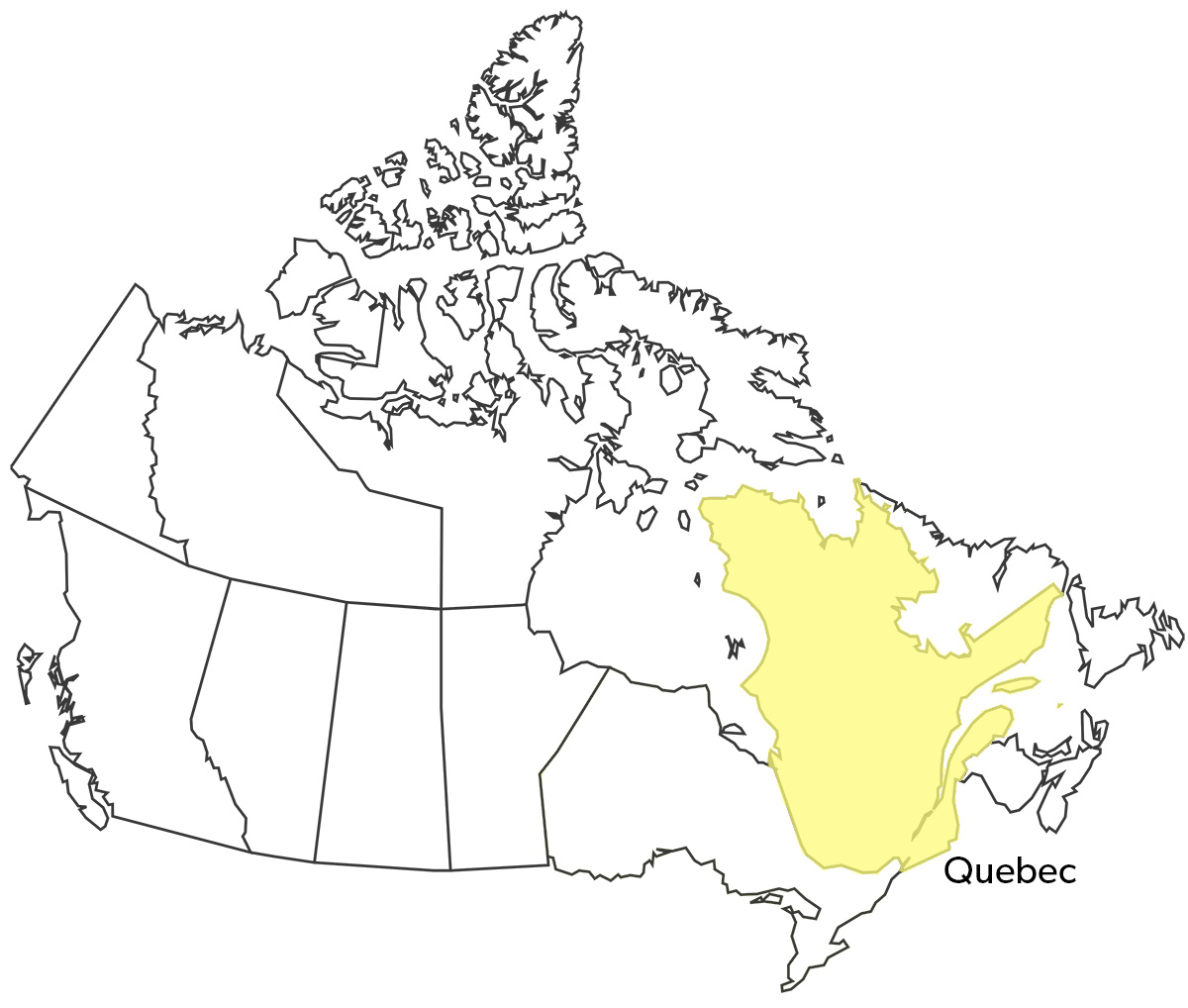
Quebec accounted for $441.4 billion, or about 20 per cent of Canada’s GDP, in 2018. Quebec, which once held the coveted economic status Ontario now holds, declined in relative terms during the second half of the 20th century. Three developments played major roles in this trend. The first was the completion of the St. Lawrence Seaway in the early 1950s, which enabled ships to bypass Montreal and thus drastically reduced its importance as a major port.
This was exacerbated by political instability (see October Crisis, Quebec Referendum 1980 and Quebec Referendum 1995) and French-only language legislation. Beginning in the 1960s, such political instability significantly reduced the incentive of international businesses to locate in the province. The faster pace of development in some other Canadian regions also influenced Quebec’s relative decline. Despite these factors, Quebec’s manufacturing and agricultural sectors benefited heavily from free trade with the United States.
In the 21st century, Quebec has re-emerged as a destination for business, and it is home to a thriving tech industry. The province has also seen a major increase in its employment rate since the 1990s. This growth is due in part to Quebec’s subsidized daycare program. Because of this policy, the gap between men and women in the workforce has narrowed in Quebec more than in any other province. Montreal remains Canada’s second largest metropolis and its second business centre. (See also Economic History of Central Canada.)
Ontario

Ontario, which has 39 per cent of Canada’s population, remains its economic motor. In 2018, the province accounted for $859.1 billion or 38 per cent of Canada’s GDP. Much of Canada’s manufacturing sector — notably industries such as auto-making, food and beverage, fabricated metals and others — is concentrated in Ontario. (And within Ontario, manufacturing is largely concentrated in the south, between Windsor and Oshawa.) However, in recent years the province has increasingly shifted to a service economy. Service industries made up 76.8 per cent of Ontario’s GDP in 2018, with manufacturing accounting for only 12.4 per cent.
Much of Ontario’s success relates to its central geographic position in Canada, its proximity to the United States market and access to waterways, which ease the import of raw materials and the shipment of finished goods to other Canadian ports and international markets. Two Ontario cities — Ottawa, the nation’s capital, with strong public sector employment, and Toronto, which has emerged as a global financial capital — have also been key motors to the province’s development. (See also Economic History of Central Canada.)
Western Canada

The four Western provinces (Manitoba, Saskatchewan, Alberta and British Columbia) contributed $795.8 billion, or about 36 per cent of the country’s GDP in 2018. The West has seen the fastest growth of all Canadian regions. Much of the development has been resource-based. Heavy investment in Alberta’s oil sands has significantly boosted employment in the province, particularly in the Fort McMurray region and has added billions of dollars in revenues to provincial government coffers. Saskatchewan has been a big beneficiary of excellent farmland and the development of its uranium, potash, shale oil and other resources, which are among the most attractive in the world. A heavy reliance on commodity prices, however, makes these provinces highly vulnerable to depressed world prices for oil and other raw resources.
British Columbia, also rich in natural resources, continues to profit from an exceptionally strong real estate sector. Vancouver is a major Pacific shipping hub, and it and Calgary are important corporate and financial centres. (See also Economic History of Western Canada.)
Northern Canada

Canada’s North is an economic region in its own right. Yukon, Northwest Territories and Nunavut are often overlooked in traditional economic analysis due to their low population density and political clout. However, the North — already an important mining region — is expected to rise in importance in the coming decades due to the melting of the polar ice caps, which is expected to one day free up a Northwest Passage for international shipping, and also open access to impressive suspected mineral and petroleum wealth.
Regional Income Disparities
The continuing disparity between Atlantic Canada and the more affluent parts of the nation such as Ontario and parts of the West, and the disparity within regions — for example, between Northern and Southern Ontario, or rural and urban Saskatchewan — are Canada’s principal regional economic problems.
During the 1980s, personal income per inhabitant (measured as GDP per capita) in the four Atlantic provinces ranged between around 60 per cent of the national average in Prince Edward Island, to about 75 per cent of the national average in Nova Scotia. By 2016, per capita income levels in Atlantic Canada had risen to between 75 and 81 per cent of the national average, except in Newfoundland and Labrador, which surpassed the national average.
Per capita income in Quebec has also remained systematically below the national average, although at levels less extreme than for Atlantic Canada. In the 1980s, per capita income in Quebec hovered at about 90 per cent of the national average. By 2016, that figure had dropped slightly to 85 per cent. The Quebec economy has been subject to conflicting forces. The dramatic decline in birthrates (since the 1960s), the growth of women in the labour force, of educational standards, and the emergence of a new francophone business class have all worked to raise incomes. On the other hand, the long threat of separation from Canada has had an economic cost, reflected in the out-migration of much of the old anglophone business elite in the 1970s and 1980s, and the decline of Montreal as a business centre.
Ontario’s per capita income has traditionally been higher than the national average and reached 114 per cent in the late 1980s. That slipped to 101 per cent in 2016, as the province’s manufacturing base, particularly the auto industry, began to slow down and hollow out (see Recession of 2008–09 in Canada).
Income disparities between the Prairie provinces and the rest of Canada are reflected in severe fluctuations in per capita income, the result of dependence upon primary production (wheat, oil, natural gas, potash) and levels of demand, which are often determined by uncontrollable natural and international factors. Saskatchewan’s per capita income has fluctuated erratically, from 59 per cent of the national average in 1941, to 87 per cent in 1951. In 2016, it was 117 per cent of the national average. Manitoba’s was 92 per cent in 2016. In recent decades, Alberta has registered the highest per capita incomes in Canada. In 2016, it was 132 per cent of the national average.
British Columbia’s per capita income has in recent decades been close to the national average. It was 99 per cent in 2016.
Impact of Oil and Gas
The income generated in an economically richer region or province (typically known as a “have” province) may flow to a poorer (“have-not”) region or province in the form of federal government transfer payments, such as equalization payments or unemployment benefits, or in interest, dividends and profits accruing to investors outside the region (see Intergovernmental Finance).
High revenues in petroleum-producing provinces have created significant wealth disparities with non-petroleum producing provinces. The surge of oil revenues in Alberta in the 1970s upset the traditional regional balance in which Ontario was the senior “have” province and chief contributor to federal transfer schemes. In the 21st century, Alberta remains Canada’s leading producer of oil and gas, however British Columbia, Saskatchewan, Newfoundland and Labrador, and to a lesser extent Nova Scotia, also earn revenue from petroleum extraction.
The global price of oil, like all natural resource commodities, can fluctuate wildly, and this caused severe slumps in the 1980s, and in 2014 and 2015 — deeply affecting revenues in petro-provinces, but not others. Severe swings of economic gain, and pain, spread unequally across regions, are the by-products of Canada’s petro-economy (see Regional Recessions in Canada).
Causes of Regional Income Disparity
Labour and Wages
Differences in per capita income between regions may exist at any time because of variations in employment, wage rates, investment income or income from government transfer schemes. In Canada, where about 70 per cent of personal income is derived from wages and from other labour income, employment and wage rates are by far the most important factors.
The uneven distribution of jobs (compared to population) in Canada is measured by variations in the proportion of the local population of working age (15–64 years); the percentage of that population in the labour force; and the unemployment rate. The proportion of the population of working age has traditionally been lower in Atlantic Canada than elsewhere, partly as a result of emigration. Labour-force participation rates have also remained low while unemployment rates have remained high in Atlantic Canada.
Regional differences in wage rates may result from differences in labour productivity and in industrial structure. The traditionally high level of per capita income in BC largely reflects high wages. However, because of influences such as unionization, labour mobility, social legislation and the weight of public service employment, a national trend towards wage equalization exists. Wage rates in Quebec and Ontario, for instance, were roughly equivalent during the 1990s.
Geographic Advantages
Regional disparities in employment and wages can be partly attributed to comparative advantages of location. The first areas to develop, because of natural or historical advantages, will often continue growing as markets, institutions and infrastructures are created. The St. Lawrence River valley was first developed because of its unique transportation advantage and agricultural potential. By building canals, roads and other infrastructure, settlers enhanced this initial natural advantage. Before Confederation, the combined population of Quebec and Ontario were already considerably larger than that of the Maritimes.
Canada’s internal market is small by world standards; one plant or office often serves the entire country. The centre of that market is situated in Southern Ontario and southwestern Quebec. Industries in the Maritimes and the Prairie Provinces are poorly located for serving the Canadian market. Modern industry and offices often require services, skills and infrastructure only found in large cities. Atlantic Canada possesses no major urban metropolis. Halifax is a small city by world standards. In the Prairies, the lack of waterways confounds the difficulty of reaching major markets and constitutes a special handicap to industrial development (see Industry in Canada).
Foreign Economic Links
The rise of the United States as Canada’s chief trading partner and source of foreign investment since the Second World War has benefited some regions more than others. Southern Ontario benefits not only from its access to the Great Lakes but also by its proximity to the major industrial zones of the American Midwest, of which it has in many ways become an extension — the development of an automobile industry in Windsor, across the river from Detroit, is an obvious example. American investment is heavily concentrated in Ontario, and Toronto is the centre for most US-controlled head offices. The integration of Canada into the North American economy has contributed to the isolation of Atlantic Canada, whose economy traditionally had strong links with Britain. In more recent decades the growth of the Pacific Rim economies (Japan, China, California) has benefited British Columbia and, to some extent, Alberta.
Human Capital
The human element is the most elusive in regional development. Migration, for example, has a decisive impact on the quality of human resources in a region. Low-income regions in Canada are often locked into a cycle of decline because the most dynamic and educated people of working age emigrate.
The resources of British Columbia and Alberta help account for their growth. BC’s high wages and productivity are the result partially of its forest resources, but also of its advantageous location and skilled labour force, and Vancouver’s role as an emerging metropolis. The Atlantic Provinces are held back not only by the lack of competitive, low-cost, natural resources, but by disadvantages of location and a history of emigration. Natural resource exploitation alone — despite its shorter-term benefits — rarely constitutes a sufficient basis for long-term, sustained economic growth. In Canada, as in other developed nations, it is today the location of manufacturing and of service industries that largely determines the emergence and persistence of regional income disparities.
Regional Economic Policies
Since Confederation, Canadian economic policy has been influenced by regional considerations. National policies have important repercussions at the regional level, intentional and unintentional, often creating tensions between the provinces and the federal government (see Federal-Provincial Relations) and among provinces.
Trade
Historically, Canada’s protective tariff structure, a legacy of Prime Minister John A. Macdonald’s National Policy, designed to encourage Canadian industrialization, primarily benefited the manufacturing areas of Quebec and Ontario, providing them with a captive domestic market. Canada’s tariff policies were historically a source of grievance in Atlantic Canada and the West, where consumers felt they were subsidizing the protected industries of Central Canada, stifling the development of their own regions. However, with the signing of the Canada-US Free Trade Agreement in 1989 and the North American Free Trade Agreement in 1993, combined with the tariff-reducing effects of GATT negotiations during the 1980s and 1990s, Canada’s tariff structure ceased to be a major regional issue (see Free Trade).
Transport Subsidies
The Maritime Freight Act (1927) provided for subsidies to reduce freight rates for rail shipments moving from points east of Lévis, Quebec, to the rest of Canada. The subsidy was subsequently raised and extended to commercial trucking. Freight rates on grain shipments out of the Prairies were kept artificially low from the turn of the century by the Crow’s Nest Pass Agreement. Prairie wheat farmers are assisted in the transport and marketing of their output by multiple subsidy schemes and by the Winnipeg-based Canadian Wheat Board. However, since the 1980s the federal government has phased out most transport subsidies.
Energy
The regional impacts of federal energy policy have often been a source of controversy. Before the 1972–74 oil crisis, energy policy favoured the oil-producing provinces because of the so-called Borden Line (1961), which divided Canada into two oil-marketing zones at the Ontario/Quebec border. West of the line no imported oil could be refined or sold; foreign oil and its by-products were limited to the market east of it. The then more expensive western oil was ensured a captive market, including Ontario. But the expansion of the Montreal- and Atlantic-based oil-refining and petrochemical industry was hampered by artificial limitation of its market at the Quebec and Ontario borders. From 1973 until the mid-1980s, the National Energy Program tended to favour oil-consuming provinces by keeping internal oil prices below international levels and by redistributing a significant portion of western oil royalties. Late in 1984, the government of Prime Minister Brian Mulroney allowed domestic oil prices to match world prices. Domestic oil prices have since joined world levels. (See also Oil and Gas Policy in Canada, 1947–80.)
Transfers and Regional Development
Canada’s comparatively generous system of transfer payment programs, comprising transfers both to other governments and to individuals (unemployment benefits, family allowances, pensions), typically accounts for about half the federal budget. Transfer payments reduce regional income disparity.
Specific federal regional development programs (RDPs) targeted at low-income regions have existed since the 1960s, initially aimed at depressed rural regions but broadened since. The federal government operates the following agencies and offices: Atlantic Canada Opportunities Agency, Canada Economic Development for Quebec Regions, Federal Economic Development Agency for Southern Ontario, Federal Economic Development Agency for Northern Ontario, Canadian Northern Economic Development Agency and Western Economic Diversification Canada. These agencies are active in promoting industry via varying financial-support measures for local firms and entrepreneurs, as well as inheriting many of the programs of former federal departments.
RDPs encompass a broad range of policies, including grants, special depreciation allowances and loans to encourage the location of firms in designated areas. Federal departments and agencies have also entered into general development agreements with the provinces, which can include infrastructure programs, mineral exploration, industrial restructuring incentives, rural development schemes, etc. The impact of RDPs has been most clearly felt in smaller regions, especially in the more depressed zones of Atlantic Canada. However, the general consensus among economists is that area-directed RDPs, such as those practised during the 1970s and 1980s, have not profoundly altered the pattern of regional development in Canada.
Other Disparities
Problems and policies similar to those on a regional or national level may be found within regions and within almost every province. Within Ontario, disparities in per capita income and employment levels between the industrialized south and the less developed north are often as substantial as they are between provinces or regions. In Quebec, per capita income and employment levels in the Gaspé region have systematically remained below those of the greater Montreal region. In Nova Scotia, Halifax is fairly prosperous while Cape Breton is economically depressed.
In most provinces, but perhaps most significantly in the West, a visible economic divide also exists between many Indigenous and non-Indigenous Canadians. The question of local economic development for Indigenous communities has emerged as a major issue in many provinces (see Economic Conditions of Indigenous Peoples in Canada). Most provinces have developed their own regional policies and objectives, often independently of the federal government.

 Share on Facebook
Share on Facebook Share on X
Share on X Share by Email
Share by Email Share on Google Classroom
Share on Google Classroom


